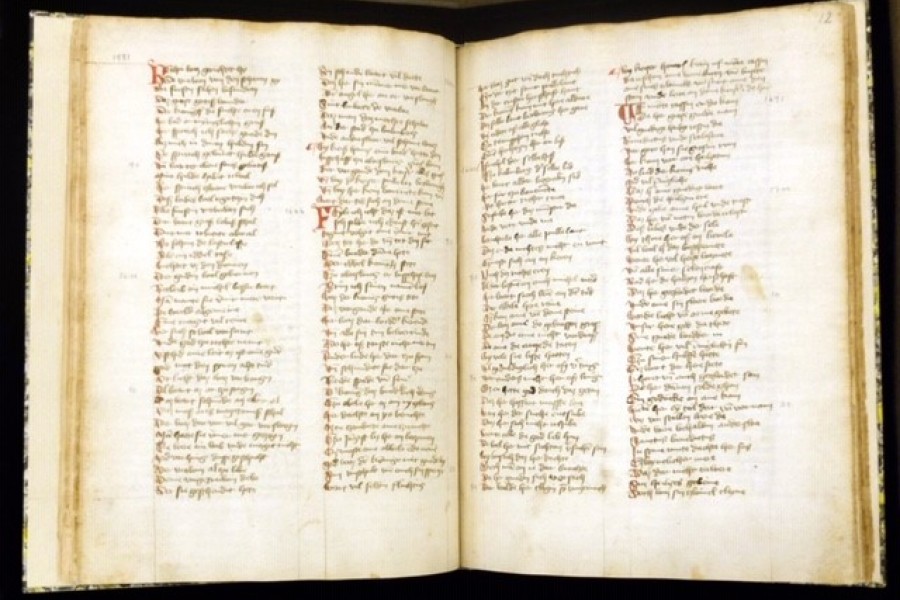Grading Standards
Language Development

Ebernand von Erfurt, Heinrich und Kunigunde (Garrett MS 133, fols 11v-12r). Manuscripts Division, Department of Rare Books and Special Collections, Princeton University Library.
The grading policies of the Department acknowledge the multi-faceted nature of the proficiencies our students need to develop: language proficiency, cultural interpretation, close reading, analysis and related skills. While all of these are intertwined, it is helpful to make two broad observations regarding their assessment in any given course:
(1) Language development and cultural/interpretive development should be assessed independently; and (2) Language development and cultural/interpretive development should be weighted differentially, depending on the level of the course.
Language development involves:
- Interpretive skills: fluent reading / listening comprehension
- Interactive skills: speaking and listening abilities geared toward conversation and classroom discussion
- Presentational skills: writing papers / making oral presentations
Progress in each these can be plotted along a spectrum:
Beginning goals
Interpretive: basic core vocabulary (1,200 words); parsing basic syntax; “extensive” reading
Interactive: controlled conversation in a language class environment
Presentational: short diary entries; five-minute oral presentations
Advanced goals
Interpretive: advanced core vocabulary (3,000 words); understanding embedded sentence structures; picking up nuances of style and register
Interactive: engaging in extended discussion and debate
Presentational: essays and short research papers; leading a seminar discussion
In the language sequence (GER 101–GER 107), language development (as outlined above) is the primary focus of attention, with content (readings, film, cultural comparisons) a secondary but nonetheless important focus.
Courses at the 200 and 300-levels, when taught in German, are assessed primarily for mastery of content and specific skills (depending on the course), with secondary emphasis on students’ language proficiency. While the precise weighting will be left to the discretion of individual instructors, a suggested distribution of 40% language proficiency to 60% content mastery for 200-level courses, and 30% to 70% for 300-level courses, can be considered the norm.
Course Participation

Image provided by Princeton University Office of Communications.
In all German Department seminars, unless stated otherwise on the syllabus, it can be presumed that course participation—attendance, rigorous preparation of assigned material, and vociferous engagement in class discussions—will account for approximately 30% of the final course grade.
Written Work

Image provided by Princeton University Office of Communications.
Despite the diversity of approaches and disciplines represented in this department (literary studies, art history, aesthetic philosophy and media theory, intellectual history, politics, applied linguistics), there is a common standard for excellent written work in all of these fields.
The following rubric will be applied to all written work for departmental seminars:
An A paper is excellent in the sense that it is elegantly written, based on thinking of a highly original kind, states and clarifies a highly interesting thesis, and defends that thesis with especially persuasive argumentation and with a well-chosen variety of specific quotations. An A paper is analytical—as opposed to merely descriptive—and demonstrates that the student has conducted a close and critical reading of the primary text or other cultural object. An A- paper would be truly excellent in most respects but slightly flawed in one or more respect. For example, an A- paper might be otherwise excellent but fail to qualify its main thesis in the way that would be required to secure a compelling demonstration of the paper’s argument.
A B paper is very good to the extent that it would typically include careful but not elegant writing. It would be based on thinking that shows some originality. It would state and clarify a reasonably interesting thesis. And it would seriously engage with potential objections. A paper that had most of these traits but also had some flashes of insight would qualify for a B+. A paper that had most of these traits but also had some more serious flaws would merit a B-.
A C paper is satisfactory in the sense that it shows evidence of sustained effort to inquire into the subject matter and to write a serious paper. Most such papers are marred by awkward, stilted, or unclear writing, poor organization, an ill-chosen main thesis that is either relatively uninteresting or too ambitious to defend adequately, and/or an argument that has trouble withstanding close scrutiny. Often, a C paper offers little more than a summary of the text under discussion or a summary of ideas and information covered in the course.
A D paper is minimally acceptable in the sense that it barely counts as a completion of the assignment. For example, the student must have studied the materials being discussed with some understanding, but most D papers are either carelessly written, lack a clearly identifiable thesis, fail to anticipate possible objections, or suffer from some combination of these weaknesses.
An F paper indicates a student’s total neglect or lack of effort in the course.




